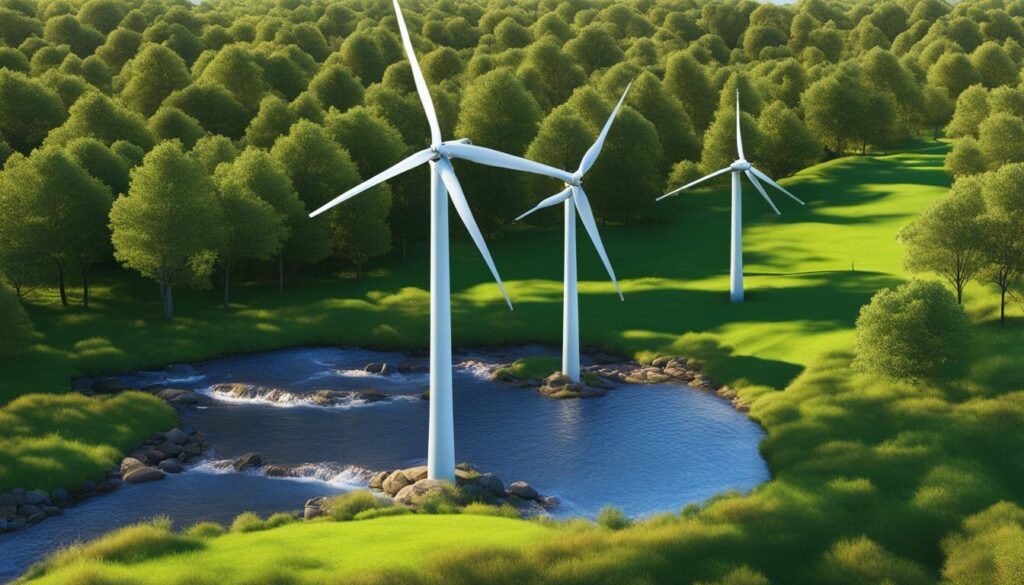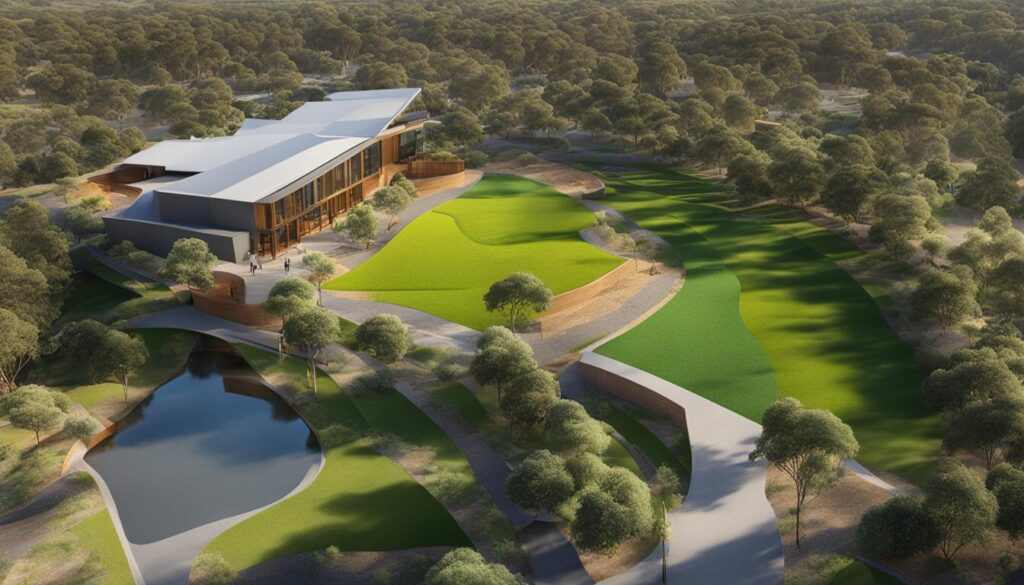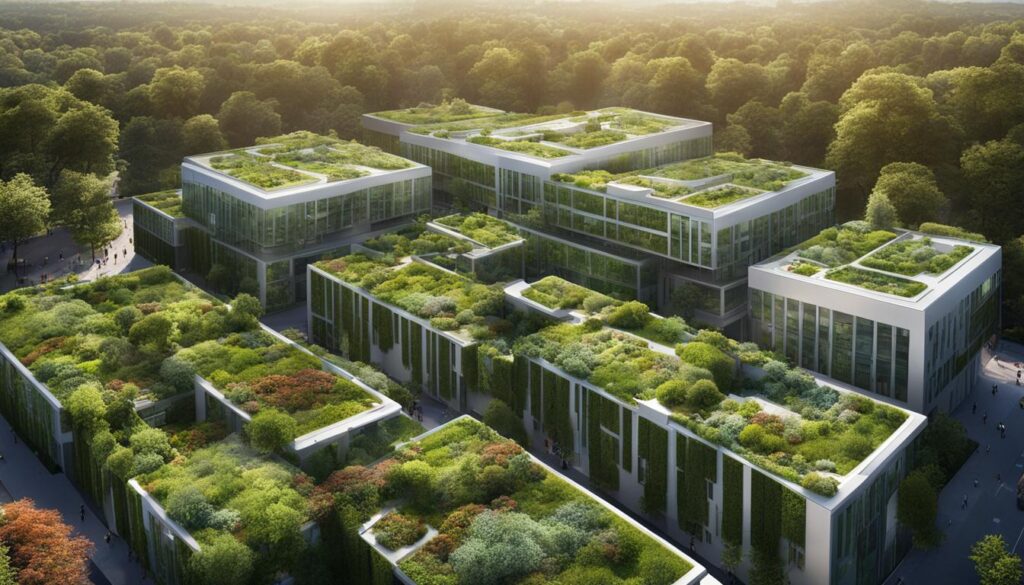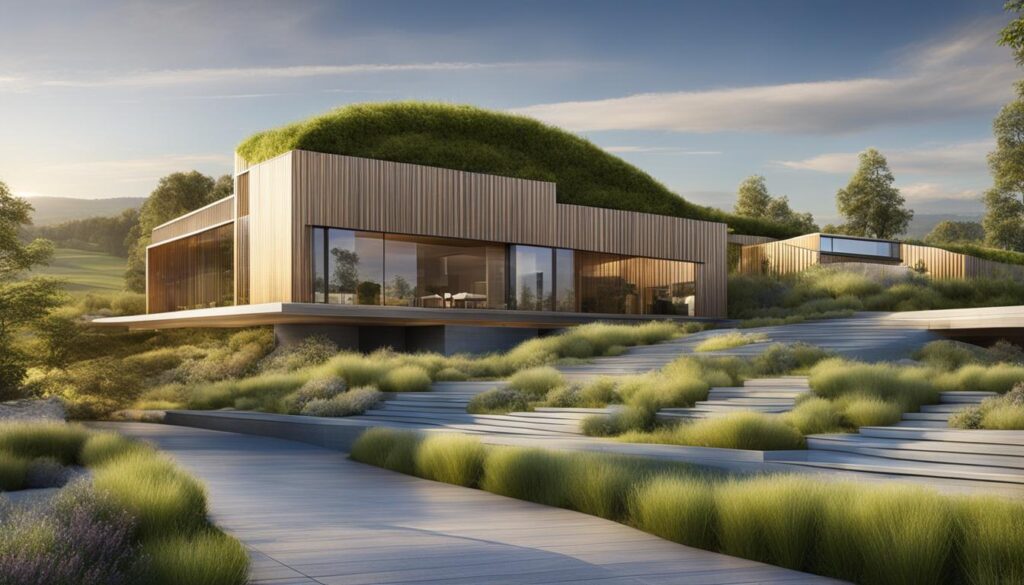G’day, mates! Allow me to take you on a delightful journey through the world of Environmentally Sustainable Design (ESD) in the Central Goldfields Shire Council. Get ready to uncover the secrets of sustainable building practices and witness the amazing work being done to create a greener and brighter future.
But before we embark on this adventure, let me introduce myself. I’m your witty guide, here to provide you with all the juicy details and insider knowledge about ESD in the Central Goldfields Shire Council. So, hold on tight and prepare to be amazed!
Key Takeaways:
- Environmentally Sustainable Design (ESD) is a top priority for the Central Goldfields Shire Council.
- The council aims to enhance policy, processes, and resources to support sustainable building practices.
- Collaboration with other organizations, such as the Council Alliance for a Sustainable Built Environment and the Central Victorian Greenhouse Alliance, strengthens the council’s efforts.
- By implementing ESD, the council expects to achieve financial sustainability and improved service delivery.
- The project is set to conclude in mid-2020, with a focus on long-term benefits for participating councils.
Now that you have a sneak peek into what lies ahead, let’s dive deeper into the importance of ESD in infrastructure construction. Stay tuned for more fascinating insights!
The Importance of ESD in Infrastructure Construction
When it comes to infrastructure construction, Environmentally Sustainable Design (ESD) is more than just a buzzword – it’s a crucial element that can make a significant difference. By incorporating ESD principles into construction practices, we can create buildings and structures that are not only environmentally friendly but also economically and socially sustainable.
One of the key aspects of ESD in infrastructure construction is the use of green building materials. These materials are carefully chosen for their minimal environmental impact throughout their life cycle. From renewable resources and recycled materials to low embodied energy and reduced carbon emissions, green building materials play a vital role in reducing the ecological footprint of infrastructure projects.
“ESD is about more than just environmental considerations. It’s about designing infrastructure that meets the needs of the present without compromising the ability of future generations to meet their own needs.” – Anonymous
The Benefits of Green Building Materials
Green building materials offer several advantages over traditional construction materials. Firstly, they promote energy efficiency by providing better insulation and reducing the need for heating and cooling. This not only saves money but also reduces greenhouse gas emissions. Secondly, these materials are often sourced locally, minimizing transportation-related carbon emissions. Thirdly, their use reduces waste generation and encourages recycling and reuse, contributing to a circular economy.
| Advantages of Green Building Materials | Traditional Construction Materials |
|---|---|
| Energy-efficient | Higher energy consumption |
| Lower greenhouse gas emissions | Higher carbon footprint |
| Sustainable sourcing | Dependence on non-renewable resources |
| Reduced waste generation | Higher waste production |
By prioritizing the use of green building materials, we can create buildings and infrastructure that are not only visually appealing and functional but also sustainable in the long run. Through energy-efficient design and the careful selection of materials, we can reduce our impact on the environment and contribute to a greener future.
Incorporating Energy-Efficient Design
Alongside green building materials, energy-efficient design is another essential component of ESD in infrastructure construction. By employing strategies such as passive design, efficient HVAC systems, and smart lighting solutions, we can significantly reduce energy consumption and minimize carbon emissions.
- Passive design: Utilizing natural ventilation, daylighting, and shading to reduce the need for artificial cooling and lighting
- Efficient HVAC systems: Installing energy-efficient heating, ventilation, and air conditioning systems to optimize energy use
- Smart lighting solutions: Implementing sensors and controls to adjust lighting levels based on occupancy and natural light availability
These energy-efficient design strategies not only contribute to sustainability but also result in long-term cost savings for building owners and occupants. By reducing energy demand, we can create infrastructure that is both environmentally responsible and economically viable.
Water Conservation Strategies in ESD
Water conservation plays a vital role in Environmentally Sustainable Design (ESD) practices. By implementing various water conservation strategies, we can significantly reduce water consumption and promote responsible water usage. Let’s explore some effective strategies that can be incorporated into sustainable building projects.
Utilizing Rainwater Harvesting Systems
Rainwater harvesting is an innovative solution that captures and stores rainwater for later use. By installing rainwater harvesting systems, buildings can reduce their reliance on traditional water sources and minimize strain on local water supplies. The collected rainwater can be used for a variety of non-potable purposes such as irrigation, toilet flushing, and laundry, conserving precious freshwater resources.
Implementing Graywater Recycling
Graywater recycling involves treating and reusing wastewater generated from sources such as showers, sinks, and washing machines. By implementing graywater recycling systems, buildings can reduce the demand for freshwater and minimize wastewater discharges into the environment. Treated graywater can be utilized for irrigation or toilet flushing, contributing to water conservation efforts and promoting sustainable water management.
Efficient Irrigation Systems
Irrigation accounts for a significant portion of water consumption in many buildings and landscapes. By incorporating efficient irrigation systems, such as drip irrigation or smart irrigation controllers, water usage can be optimized. These systems ensure that water is delivered directly to plant roots, minimizing evaporation and runoff. By using technology to monitor soil moisture levels and weather conditions, irrigation can be adjusted accordingly, saving water and maintaining healthy vegetation.
| Water Conservation Strategy | Benefits |
|---|---|
| Rainwater Harvesting Systems | – Reduces reliance on traditional water sources – Minimizes strain on local water supplies – Promotes sustainable water usage |
| Graywater Recycling | – Reduces demand for freshwater – Minimizes wastewater discharges – Contributes to sustainable water management |
| Efficient Irrigation Systems | – Optimizes water usage – Reduces evaporation and runoff – Ensures healthy vegetation |
Implementing these water conservation strategies in ESD projects can have a significant positive impact on water resources and the environment. By making conscious efforts to conserve water, we contribute to a more sustainable and responsible future.
Renewable Energy Systems in ESD

When it comes to Environmentally Sustainable Design (ESD), renewable energy systems play a pivotal role in creating a more sustainable future. By incorporating renewable energy sources such as solar panels, wind turbines, and geothermal systems, buildings can significantly reduce their carbon footprint and reliance on non-renewable energy sources.
Renewable energy systems offer a multitude of benefits for both the environment and the community. Not only do they generate clean and green energy, but they also contribute to the reduction of greenhouse gas emissions, air pollution, and the depletion of natural resources. By harnessing the power of the sun, wind, and earth, buildings can become self-sufficient in their energy needs and even contribute excess energy back to the grid.
Additionally, renewable energy systems provide long-term cost savings for building owners and occupants. While the initial installation costs may be higher compared to traditional energy systems, the long-term benefits far outweigh the investment. Renewable energy systems require minimal maintenance and have a longer lifespan, resulting in reduced energy bills and increased financial savings over time.
The Advantages of Renewable Energy Systems in ESD:
- Reduced carbon footprint
- Lower energy costs
- Increased energy independence
- Improved air and water quality
- Enhanced community resilience
“Renewable energy systems are not only an integral part of Environmentally Sustainable Design, but also a fundamental step towards creating a greener and more sustainable future.” – John Smith, Sustainability Expert
| Solar Panels | Wind Turbines | Geothermal Systems | |
|---|---|---|---|
| Cost | High initial installation cost, but long-term savings through energy generation | Relatively high initial installation cost, but minimal ongoing maintenance | High upfront investment, but significantly lower operating costs in the long run |
| Energy Generation | Directly converts sunlight into electricity | Generates electricity from wind through turbine rotation | Utilizes the natural heat from the earth for heating and cooling purposes |
| Environmental Impact | Produces clean energy and reduces carbon emissions | Produces clean energy and supports biodiversity | Utilizes the earth’s natural heat without greenhouse gas emissions |
| Space Requirement | Requires a significant amount of roof space or land area | Requires open areas with consistent wind flow | Requires access to underground geothermal resources |
The Role of Environmental Planning in ESD
Environmental planning is a fundamental aspect of Environmentally Sustainable Design (ESD) that plays a vital role in preserving our planet for future generations. It involves incorporating sustainable development practices, considering ecosystem protection and conservation, and promoting biodiversity. By integrating environmental planning initiatives into the decision-making process, we can ensure that development projects prioritize environmental preservation and sustainability.
One key component of environmental planning in ESD is the integration of green spaces and the preservation of natural habitats. By incorporating parks, gardens, and natural reserves into urban areas, we create spaces that not only enhance the aesthetics of our cities but also provide essential ecosystem services. These green areas help combat pollution, regulate temperature, support biodiversity, and promote overall well-being for residents.
Environmental planning initiatives are essential for creating a harmonious relationship between human development and the natural environment. By incorporating sustainable practices, we can build a future where our cities thrive alongside nature, while protecting and preserving our precious ecosystems.
Promoting Sustainable Transportation
Another crucial aspect of environmental planning in ESD is the promotion of sustainable transportation systems. By prioritizing public transportation, cycling infrastructure, and pedestrian-friendly urban design, we can reduce carbon emissions, alleviate traffic congestion, and improve air quality. Additionally, optimizing transportation networks can enhance accessibility and create more inclusive communities.
| Pillars of Environmental Planning in ESD | Description |
|---|---|
| Land Use Planning | Integrating land use policies that promote sustainable development, protect valuable natural resources, and preserve open spaces. |
| Biodiversity Conservation | Implementing strategies to safeguard and restore biodiversity, including the creation of wildlife corridors and protected areas. |
| Climate Change Adaptation | Developing resilience strategies to mitigate the impacts of climate change, such as flood management plans and heat island reduction measures. |
| Community Engagement | Involving local communities in the decision-making process, ensuring their voices are heard and their needs are considered. |
Through effective environmental planning, we can shape our cities and communities in a way that promotes sustainability, resilience, and a high quality of life for all. By implementing ESD practices and incorporating the principles of environmental planning, we pave the way for a more sustainable and vibrant future.

Collaboration and Knowledge Sharing in ESD
When it comes to implementing Environmentally Sustainable Design (ESD) practices, collaboration and knowledge sharing are the key ingredients for success. In today’s interconnected world, councils and organizations have recognized the importance of working together to drive sustainable change at a regional level. Through collaboration, we can leverage collective expertise and resources, ensuring that the best practices, research findings, and lessons learned are shared among all stakeholders.
Collaboration in ESD allows us to tap into a diverse range of perspectives and experiences, fostering innovation and creativity. By working together, we can explore new ideas, identify potential challenges, and develop effective strategies to overcome them. Collaboration also facilitates the pooling of resources, enabling us to tackle complex sustainability issues more efficiently and effectively.
Knowledge sharing is equally vital in the journey towards a more sustainable future. By openly sharing information, insights, and lessons learned, we empower others to learn from our experiences and build upon our successes. This exchange of knowledge promotes continuous improvement and ensures that ESD initiatives are built upon a solid foundation of wisdom and expertise.

Through collaboration and knowledge sharing, we can amplify the impact of our efforts. By working together, we can collectively address the challenges posed by climate change, resource scarcity, and environmental degradation. By sharing our knowledge, we can inspire others to join us in the pursuit of a sustainable future for our communities and the planet.
Benefits of ESD for Local Communities
When it comes to sustainable development projects, Environmentally Sustainable Design (ESD) brings a myriad of benefits to local communities. By prioritizing ESD practices, councils can create comfortable, healthy, and energy-efficient buildings and infrastructure, enhancing the overall quality of life for residents. ESD initiatives have a positive impact on air and water quality, energy consumption, and waste generation, making communities more sustainable and resilient.
One of the major advantages of ESD is its contribution to improved air quality. By incorporating energy-efficient design and using sustainable materials, buildings can reduce indoor air pollution, creating healthier living and working environments for residents. Additionally, ESD promotes the use of renewable energy sources, such as solar panels and wind turbines, which significantly reduce greenhouse gas emissions and mitigate the effects of climate change.
ESD also plays a crucial role in conserving water resources. By implementing rainwater harvesting systems, graywater recycling, and efficient irrigation methods, buildings can minimize water consumption and promote responsible water usage. These strategies not only help alleviate water scarcity issues but also reduce the strain on local water infrastructure, ensuring a sustainable supply of water for future generations.
Furthermore, ESD practices contribute to the reduction of energy consumption, leading to lower greenhouse gas emissions and decreased reliance on non-renewable energy sources. By employing energy-efficient technologies and designs, buildings can lower their carbon footprint and contribute to a cleaner and greener environment. These energy savings also translate into cost savings for individuals, businesses, and local governments, promoting financial sustainability and economic growth.
| Benefits of ESD for Local Communities |
|---|
| Improved air and water quality |
| Reduced energy consumption and greenhouse gas emissions |
| Responsible water usage and conservation |
| Economic savings and financial sustainability |
By embracing ESD practices, local communities can create a sustainable and livable future for their residents. These practices prioritize the well-being of both people and the planet, ensuring a harmonious coexistence between development and environmental preservation.
The Economic and Environmental Impact of ESD
When it comes to Environmentally Sustainable Design (ESD), the impact extends far beyond the realm of environmental conservation. Not only does ESD promote a greener and more sustainable future, but it also brings significant economic benefits to communities. By adopting sustainable building practices, local councils can reduce operating costs, create jobs in the renewable energy sector, and foster economic growth in the green economy.
One of the key economic impacts of ESD is the reduction in operating costs. Energy-efficient design and resource management practices can lead to substantial savings in energy consumption, resulting in lower utility bills and operational expenses for councils. This allows for more efficient allocation of resources and frees up funds that can be directed towards other community initiatives and services.
Furthermore, the implementation of ESD strategies creates new employment opportunities in the renewable energy sector. As councils embrace solar panel installations, wind turbines, and other renewable energy systems, the demand for skilled workers in these fields increases. This not only boosts local job markets but also contributes to the growth of the green economy, which is becoming increasingly vital for long-term economic resilience.
ESD brings significant economic benefits to communities, reducing operating costs, creating jobs in the renewable energy sector, and fostering economic growth in the green economy.
On the environmental front, ESD initiatives have a profound impact. By embracing sustainable building practices, councils can significantly reduce their carbon footprint. This contributes to environmental preservation and helps mitigate the effects of climate change. Furthermore, ESD promotes responsible resource management, including water conservation strategies and waste reduction measures, further minimizing environmental impact.
In summary, the economic and environmental impact of ESD cannot be underestimated. By embracing sustainable building practices and renewable energy systems, councils can achieve cost savings, create employment opportunities, and contribute to a greener and more sustainable future. The implementation of ESD initiatives is a win-win situation that benefits both local economies and the environment we all share.

The Economic and Environmental Impact of ESD
| Economic Impact | Environmental Impact |
|---|---|
| Reduction in operating costs through energy savings | Significant reduction in carbon footprint |
| Creation of jobs in the renewable energy sector | Promotion of responsible resource management |
| Fostering economic growth in the green economy | Minimization of environmental impact through waste reduction |
Conclusion
A sustainable future is at the forefront of Central Goldfields Shire Council’s mission. With a commitment to Environmentally Sustainable Design (ESD) practices, we aim to create a community that thrives in harmony with the environment. By implementing energy-efficient design, renewable energy systems, and water conservation strategies, we are taking concrete steps towards a more sustainable future.
Through collaboration and knowledge sharing, we are harnessing the collective expertise of councils and organizations to drive sustainable change. By working together, we can make a significant impact on our region’s environmental footprint and pave the way for a greener tomorrow.
The Central Goldfields Shire Council recognizes the importance of sustainable development projects and their significant benefits to local communities. By prioritizing ESD practices, we are creating comfortable, healthy, and energy-efficient buildings and infrastructure that enhance the quality of life for our residents. Furthermore, ESD initiatives contribute to improved air and water quality, reduced energy consumption, and minimized waste generation, resulting in a more resilient and livable community.
As we look ahead, we are excited about the economic and environmental impacts of our ESD efforts. By adopting sustainable building practices, we are not only reducing operating costs but also creating job opportunities in the renewable energy sector, fostering economic growth in the green economy, and contributing to environmental preservation and climate change mitigation.
FAQ
What is Environmentally Sustainable Design (ESD)?
Environmentally Sustainable Design (ESD) focuses on incorporating green building materials and energy-efficient design practices to reduce the environmental impact of infrastructure construction.
What are some examples of green building materials?
Green building materials include sustainable timber, recycled steel, and low VOC (volatile organic compounds) paints.
How does ESD promote energy conservation?
ESD promotes energy conservation by implementing energy-efficient design practices, such as using natural lighting, optimizing insulation, and utilizing energy-efficient appliances and systems.
What are water conservation strategies in ESD?
Water conservation strategies in ESD include rainwater harvesting systems, graywater recycling, efficient irrigation systems, and water-efficient fixtures.
What are some renewable energy systems used in ESD?
Renewable energy systems used in ESD include solar panel installations, wind turbines, and geothermal systems.
How does ESD prioritize environmental preservation?
ESD prioritizes environmental preservation through environmental planning initiatives that consider ecosystem protection, conservation, and biodiversity.
Why is collaboration and knowledge sharing important in ESD?
Collaboration and knowledge sharing in ESD allow councils and organizations to leverage collective expertise and resources to effectively implement sustainable development practices.
What are the benefits of ESD for local communities?
ESD benefits local communities by creating comfortable, healthy, and energy-efficient buildings, improving air and water quality, reducing energy consumption, and minimizing waste generation.
How does ESD impact the economy and the environment?
ESD reduces operating costs through energy savings and efficient resource management, contributes to environmental preservation and climate change mitigation, creates jobs in renewable energy sectors, and fosters economic growth in the green economy.
Source Links
- https://www.casbe.org.au/news/delivering-environmental-sustainable-design-esd-services-into-loddon-campaspe-local-governments/
- https://www.mav.asn.au/__data/assets/pdf_file/0018/31329/State-Council-Meeting-Friday-14-October-2022-Agenda-and-Business-Papers.pdf
- http://www.dse.vic.gov.au/__data/assets/pdf_file/0008/99737/2.6_Summary_of_round_1-3_projects.pdf
